Wire Grid Beamsplitter Cube in 30 mm Cage Cube
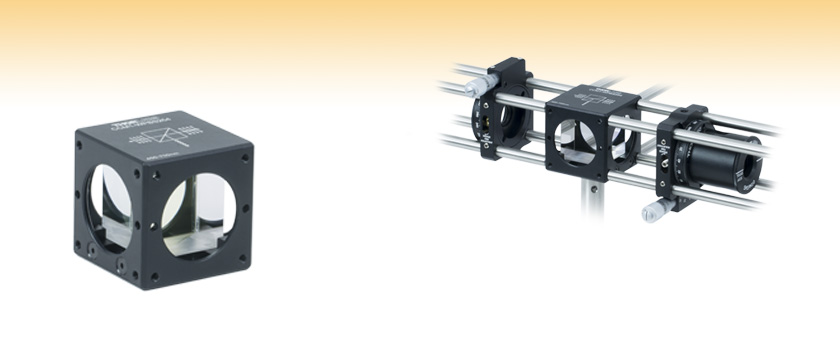
- Polarizes and Splits Wavelengths from 400 to 700 nm
- High Extinction Ratio: >1 000:1 for Transmitted Beam
- SM1 and 30 mm Cage System Compatible
- Engraved Housing
CCM1-WPBS254
30 mm Wire Grid Beamsplitter
Application Idea
The CCM1-WPBS254 can be used in conjunction with a linear polarizer and a quarter-wave plate to create a basic isolator.

Please Wait
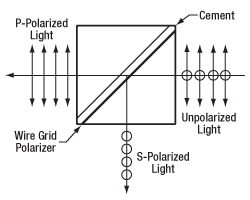
Transmission and Reflection of Light Through a Wire Grid Polarizing Beamsplitter Cube
(Not to Scale)

Click for Details
Each mounted wire grid beamsplitter cube is engraved with a ray diagram for one of the two preferred entrance faces.
Features
- Transmits P-Polarized Light and Reflects S-Polarized Light
- High Extinction Ratio
- TP:TS > 1000:1 (AOI: 0° - 5°)
- TP:TS > 100:1 (AOI: 0° - 25°)
- Design Wavelength: 400 - 700 nm
- 1" (25.4 mm) Cubes in 30 mm Cage System Compatible Mounts with Four SM1-Threaded (1.035"-40) Ports
- Bottom-Located 8-32 or M4 Tap for Post Mounting
- Connect Two Cage Cubes Side by Side with the CM1-CC Cage Cube Connector
Thorlabs offers wire grid polarizing beamsplitter cubes mounted in 30 mm cage system compatible housings with SM1-threaded ports. The mounted cubes consist of an array of parallel metallic wires between two N-BK7 prisms joined with optical cement. Wire grid polarizers transmit radiation with an electric field vector perpendicular to the wire and reflect radiation with the electric field vector parallel to the wire. This cube separates the s- and p-polarized components of lights by reflecting the s-polarized component at the wire grid, while allowing the p-polarized component to pass. Due to surface reflections, the reflected beam contains both polarizations.
These beamsplitter cubes have a larger angle of incidence (AOI) than traditional broadband polarizing beamsplitter cubes. For the highest polarization extinction ratio, use the transmitted beam, which offers an extinction ratio of TP:TS
The wire grid is sandwiched between the hypotenuses of the two prisms that make up the cube. Then, optical cement is used to bind the two prism halves together (refer to the diagram above). Light can be input into any of the polished faces to separate the s- and p-polarized components. One possible orientation is engraved on the top of the cage cube.
Cage System Compatibility
A bottom-located 8-32 or M4 tap is included on each housing for post mounting. The housings feature four SM1-threaded entrance and exit ports for compatibility with our SM1 (1.035"-40) lens tubes. Four 4-40 tapped holes surrounding each port provide compatibility with our 30 mm cage systems. These mounted beamsplitter cubes can be connected to other cage cubes through the use of our cage rods and ERSCB adapters or can be connected side-by-side to other cage cubes with our CM1-CC connector.
Other Cage Cube Options
We also offer unmounted versions of our wire grid beamsplitters in various sizes. Custom beamsplitter cubes can be ordered by contacting Tech Support. For high-power applications, we also offer high-power polarizing beamsplitting cubes that have damage thresholds greater than 10 J/cm2. We also offer polarizing beamsplitter cubes at laser line wavelengths, which have a high extinction ratio of >3 000:1 (TP:TS).
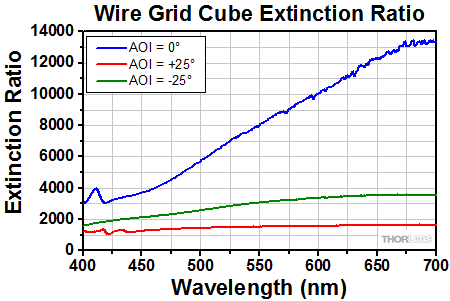
Click to Enlarge
Click for Raw Data
The graph above shows the measured extinction ratio (ER) for transmitted light for light incident upon one of the entrance faces. The extinction ratio (also known as contrast) is the ratio of the maximum transmission of a sufficiently linearly polarized signal when the polarizer’s axis is aligned with the signal to the minimum transmission when the polarizer is rotated by 90°. The plotted data is given for AOIs of 0° and ±25°.
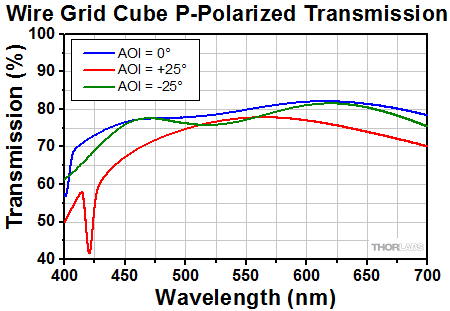
Click to Enlarge
Click for Raw Data
The graph above shows the measured transmission through the wire grid polarizing cube for p-polarized light for light incident upon one of the entrance faces. The plotted data is given for AOIs of 0° and ±25°.
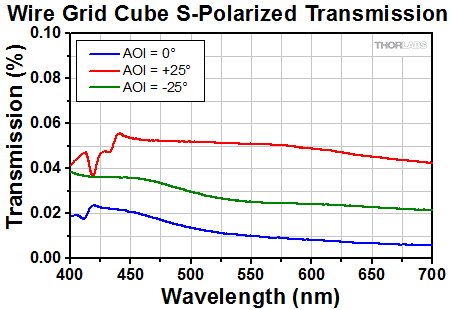
Click to Enlarge
Click for Raw Data
The graph above shows the measured transmission through the wire grid polarizing cube for s-polarized light for light incident upon one of the entrance faces. The plotted data is given for AOIs of 0° and ±25°.
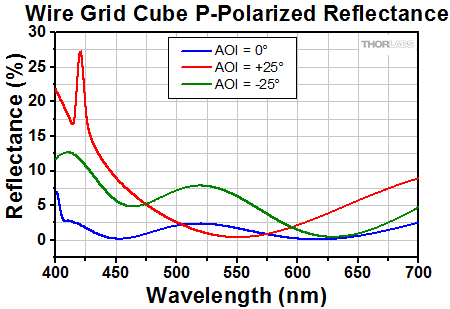
Click to Enlarge
Click for Raw Data
The graph above shows the measured reflectance from the wire grid polarizing cube for p-polarized light for light incident upon one of the entrance faces. The plotted data is given for AOIs of 0° and ±25°.
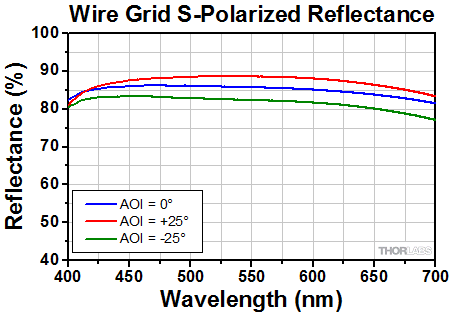
Click to Enlarge
Click for Raw Data
The graph above shows the measured reflectance from the wire grid polarizing cube for s-polarized light for light incident upon one of the entrance faces. The plotted data is given for AOIs of 0° and ±25°.
Polarizer Selection Guide
Thorlabs offers a diverse range of polarizers, including wire grid, film, calcite, alpha-BBO, rutile, and beamsplitting polarizers. Collectively, our line of wire grid polarizers offers coverage from the visible range to the beginning of the Far-IR range. Our nanoparticle linear film polarizers provide extinction ratios as high as 100 000:1. Alternatively, our other film polarizers offer an affordable solution for polarizing light from the visible to the Near-IR. Next, our beamsplitting polarizers allow for use of the reflected beam, as well as the more completely polarized transmitted beam. Finally, our alpha-BBO (UV), calcite (visible to Near-IR), rutile (Near-IR to Mid-IR), and yttrium orthovanadate (YVO4) (Near-IR to Mid-IR) polarizers each offer an exceptional extinction ratio of 100 000:1 within their respective wavelength ranges.
To explore the available types, wavelength ranges, extinction ratios, transmission, and available sizes for each polarizer category, click More [+] in the appropriate row below.
| Wire Grid Polarizers |
|---|
| Film Polarizers |
|---|
| Beamsplitting Polarizers |
|---|
| alpha-BBO Polarizers |
|---|
| Calcite Polarizers |
|---|
| Quartz Polarizers |
|---|
| Magnesium Fluoride Polarizers |
|---|
| Yttrium Orthovanadate (YVO4) Polarizers |
|---|
| Rutile Polarizers |
|---|
| Posted Comments: | |
Tim Weber
(posted 2020-06-29 21:51:26.063) Would it be possible to fabricate an NIR-version of this beam splitter? YLohia
(posted 2020-07-02 09:05:08.0) Hello Tim, thank you for contacting Thorlabs. Custom optics can be requested by emailing techsupport@thorlabs.com. We will reach out to you directly to discuss the possibility of offering this. |
Beamsplitter Selection Guide
Thorlabs' portfolio contains many different kinds of beamsplitters, which can split beams by intensity or by polarization. We offer plate and cube beamsplitters, though other form factors exist, including pellicle and birefringent crystal. For an overview of the different types and a comparison of their features and applications, please see our overview. Many of our beamsplitters come in premounted or unmounted variants. Below is a complete listing of our beamsplitter offerings. To explore the available types, wavelength ranges, splitting/extinction ratios, transmission, and available sizes for each beamsplitter category, click More [+] in the appropriate row below.Plate Beamsplitters
| Non-Polarizing Plate Beamsplitters |
|---|
| Polarizing Plate Beamsplitters |
|---|
Cube Beamsplitters
| Non-Polarizing Cube Beamsplitters |
|---|
| Polarizing Cube and Polyhedron Beamsplitters |
|---|
Pellicle Beamsplitters
| Non-Polarizing Pellicle Beamsplitters |
|---|
Crystal Beamsplitters
| Polarizing Crystal Beamsplitters |
|---|
Other
| Other Beamsplitters |
|---|

| Specifications | ||
|---|---|---|
| Beamsplitter | ||
| Design Wavelength | 400 - 700 nm | |
| Extinction Ratioa | Tp:Ts > 1 000:1 @ 0° - 5° AOI Tp:Ts > 100:1 @ 0° - 25° AOI |
|
| Surface Quality | 40-20 Scratch-Dig (Four Side Faces) 80-50 Scratch-Dig (Hypotenuse) |
|
| AR Coating Reflectance (@ 0°AOI) | Ravg < 0.5% for 400 - 700 nm | |
| Transmission | Tp > 75% (Avg.) @ 0° AOI for 400 - 700 nm | |
| Reflectance | Rs > 70% @ 0° - 25° AOI for 400 - 700 nm | |
| Transmitted Wavefront Error | <λ/4 @ 633 nm (rms) | |
| Material | N-BK7 | |
| Unmounted Cube Item # | WPBS254-VIS | |
| Assembly | ||
| Transmitted Beam Deviation | <20 arcmin | |
| Reflected Beam Deviation | 90° ± 20 arcmin | |
| Outer Dimensions | 1.50" × 1.50" × 1.50" (38.1 mm × 38.1 mm × 38.1 mm) |
|
| Clear Aperture | >Ø22.9 mm | |
| Cage Cube Material | Anodized Aluminum | |
| Mounting Hole | Imperial: 8-32 Tapped Hole Metric: M4 Tapped Hole |
|
- Design Wavelength: 400 - 700 nm
- Antireflective (AR) Coatings for 400 - 700 nm
(Ravg < 0.5% @ 0° AOI) - High Extinction Ratio
- TP:TS > 1000:1 (AOI: 0° - 5°)
- TP:TS > 100:1 (AOI: 0° - 25°)
Thorlabs' Wire Grid Beamsplitters are constructed with a 1" wire grid beamsplitter cube mounted in 30 mm cage cube. This cube separates the s- and p-polarized components by reflecting the
s-polarized component at the wire grid, while allowing the
p-polarized component to pass.
The highest polarization extinction ratio for this cube, Tp:Ts > 1 000:1, can be achieved using the transmitted beam for an AOI from 0° to 5°. For a higher AOI (5° to 25°) this cube can maintain an extinction ratio of TP:TS > 100:1. These beamsplitter cubes faces' are coated with an AR coating giving Ravg < 0.5% per surface at the design wavelength. The clear aperture for this optic is Ø22.9 mm.

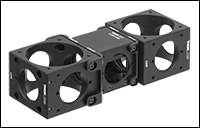
Click to Enlarge
A C4W and C6W Cage Cube connected to a 1.5" wide CCM1-4ER Compact Cage Cube using the C4W-CC and CM1-CC Cube Connectors, respectively.
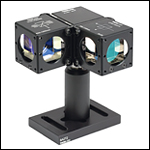
Click to Enlarge
CM1-CC Connecting Multiple 1.5" Wide Cage Cubes
- Connect Two 1.5" Wide Cage Cubes Side by Side
- Connect a 1.5" Wide Cage Cube to a 2" Wide Cage Cube
- Compatible with CM1 or CCM1 Series Cage Cubes
The CM1-CC cage cube connector allows two or more CM1 or CCM1 style cubes to be connected as shown in the image to the right. The CM1 and CCM1 series of cage cubes, which are all compatible with this connector, include empty cubes, empty dichroic cubes, mounted beamsplitters, mounted penta prisms, and mounted turning mirrors. The CM1-CC cage cube connector includes four 4-40 button-head screws, two 4-40 flat-head screws, four washers, and a 1/16" hex key.
Two cage cube-mounted turning mirrors cannot be connected using the CM1-CC due to a lack of Ø6 mm cage rod holes on two sides of the cube.
We also offer the C4W-CC to connect two 2" wide 30 mm cage cubes. Both C4W-CC and CM1-CC cage cube connectors can be used to connect one 1.5" wide 30 mm cage cube, such as our CCM1-4ER(/M), with a 2" wide 30 mm cage cube.
Alignment Pins
Please note that because dowel alignment pins are used, the connector requires drilled holes on the cube face between the SM1-threaded (1.035"-40) ports. If you have an older cube and would like it updated to have alignment holes for free, please contact Technical Support. Alternatively, the alignment pins are press-fit inside their mounting holes, and can be pressed out for use with cubes that do not have these alignment holes.
 Products Home
Products Home








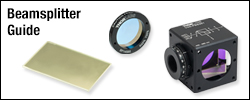
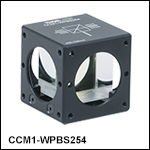
 Zoom
Zoom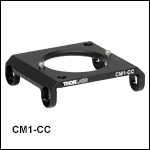
 Mounted Wire Grid Polarizing Beamsplitter Cubes
Mounted Wire Grid Polarizing Beamsplitter Cubes